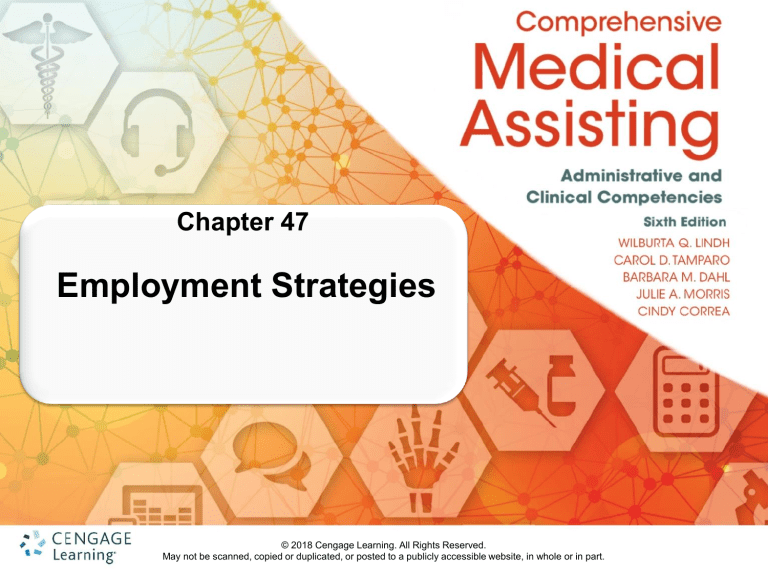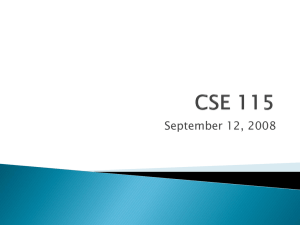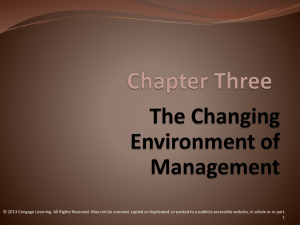
Chapter 47 Employment Strategies © 2018 Cengage Learning. All Rights Reserved. May not be scanned, copied or duplicated, or posted to a publicly accessible website, in whole or in part. Developing a Strategy • Attitude and mindset - Evolve a positive attitude - Innate personality - Being successful in your job search requires positive thinking • Self-assessment - Strengths and weaknesses - Identify what you want in a job - Direct and transferable skills - Required income © 2018 Cengage Learning. All Rights Reserved. May not be scanned, copied or duplicated, or posted to a publicly accessible website, in whole or in part. 2 The Job Search • Instructors/other professionals • Visit or telephone clinics to determine duties of a medical assistant • Social media (used by 95% of employers) • Person-to-person and professional organization networking • Internet blogs • Post an online profile • Type of clinic or practice you want to work in • Geographical area where you want to work © 2018 Cengage Learning. All Rights Reserved. May not be scanned, copied or duplicated, or posted to a publicly accessible website, in whole or in part. 3 Résumé Preparation or Online Profile • A résumé is a summary of your qualifications • The purpose is to sell you • Never fabricate information (see Table 47-1: Top 10 Lies on Résumés) • List of references • Styles - Chronological/functional/targeted - Online profiles/e-résumés - See Procedure 47-1: Preparing a Résumé © 2018 Cengage Learning. All Rights Reserved. May not be scanned, copied or duplicated, or posted to a publicly accessible website, in whole or in part. 4 Online Profile • LinkedIn profile example - Accurate photo - Headline - Use action words - Work summary - Be specific and personable - Highlight achievements - Do not leave current job empty - Use of LinkedIn recommendations • E-résumé © 2018 Cengage Learning. All Rights Reserved. May not be scanned, copied or duplicated, or posted to a publicly accessible website, in whole or in part. 5 Application/Cover Letters • Introducing yourself to potential employers • Highlights qualifications and experience • Enhances résumé • Reflect how your skills satisfy the employer's needs • Business style, one page in length - Address to specific individual - Keep concise, use correct grammar and spelling, follow standard format - Have someone review © 2018 Cengage Learning. All Rights Reserved. May not be scanned, copied or duplicated, or posted to a publicly accessible website, in whole or in part. 6 Completing the Application Form • Answer every item completely • Application organized to suit needs of employer • Read all directions carefully • Use black ink - Print clearly and without errors - Make a copy prior to completing - May be asked to complete an application “on the spot,” be prepared © 2018 Cengage Learning. All Rights Reserved. May not be scanned, copied or duplicated, or posted to a publicly accessible website, in whole or in part. 7 The Interview Process • Interview is meeting in which you and interviewer discuss employment opportunities within particular organization • Being well prepared will increase your selfconfidence • Will assess your appearance, attitude, and dependability • The look of success - First impressions are lasting © 2018 Cengage Learning. All Rights Reserved. May not be scanned, copied or duplicated, or posted to a publicly accessible website, in whole or in part. 8 Preparing for the Interview • Research the organization offering the position • Bring copies of résumé, reference list, letters of recommendation, application, and cover letter • Be sure you know the name of your interviewer • Arrive 5-10 minutes early • Introduce yourself confidently • See Quick Reference Guide: Reasons for Employers Not Hiring © 2018 Cengage Learning. All Rights Reserved. May not be scanned, copied or duplicated, or posted to a publicly accessible website, in whole or in part. 9 The Actual Interview • • • • • • • • Firm handshake and smile Remain standing until you are asked to sit Sit erect with your feet flat on the floor Be natural and positive Present a professional image, do not repeat yourself Answer all questions completely Think before answering questions See Quick Reference Guide: Typical Questions Asked during an Interview • Danger signs of an employer who could make life difficult © 2018 Cengage Learning. All Rights Reserved. May not be scanned, copied or duplicated, or posted to a publicly accessible website, in whole or in part. 10 Closing the Interview • Observe the interviewer and listen carefully to determine when he/she has enough information to make a decision • Interviewer will ask if you have any questions • Questions provide another opportunity to sell yourself • Examples of questions about the organization you may ask • Thank the interviewer for taking the time to discuss the position • Exit with a handshake and a smile © 2018 Cengage Learning. All Rights Reserved. May not be scanned, copied or duplicated, or posted to a publicly accessible website, in whole or in part. 11 Interview Follow-up • Telephone references • Follow-up letter (see Procedure 47-2: Prepare an Interview Follow-Up Letter and Figure 47-8) - Day or two after interview - Express interest in organization - Express being considered for position • Follow up by telephone - Week after interview - Tell reason for calling - Thank person © 2018 Cengage Learning. All Rights Reserved. May not be scanned, copied or duplicated, or posted to a publicly accessible website, in whole or in part. 12 After You Are Employed (Slide 2 of 2) • Advancing your career suggestions - Make sure your workstation is set up - Practice good time management skills - Try to allow time for emergencies - Do not be a know-it-all; ask other employees - how they do things around here - Get to know colleagues and be part of the team - Seek feedback on how you are doing your job - • Create a professional image © 2018 Cengage Learning. All Rights Reserved. May not be scanned, copied or duplicated, or posted to a publicly accessible website, in whole or in part. 13 After You Are Employed (Slide 2 of 2) • Dealing with difficult people - Check out emotionally - Try to move to a different position within the organization - If all else fails, change jobs • Getting a raise - One of the main reasons people do not get a raise is because they do not ask © 2018 Cengage Learning. All Rights Reserved. May not be scanned, copied or duplicated, or posted to a publicly accessible website, in whole or in part. 14





